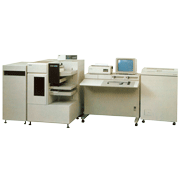Toshiba’s OCR-V595 was the industry’s first commercial OCR system that could read handwritten kanji characters. A general-purpose form reader for letters, number, katakana characters, and symbols, it had an optional function for reading handwritten kanji characters. The OCR-V595 was the flagship model of Toshiba’s OCR-V series and it featured large-volume, high-speed reading, high recognition accuracy, free-format reading with few limitations on the formatting of forms, functions for reading without outline boxes, and an ordinary handwritten character reading function that read easily confused characters and cursive characters.
Toshiba used the multiple similarity method for character recognition on the OCR-V595. This demonstrated the method was applicable to handwritten kanji characters as well as letters, numbers, katakana characters, and symbols. The key problem with recognizing kanji characters is the many character types. Toshiba solved this problem with large categorization technology, which roughly categorized characters quickly, and IC chips designed specifically for high-speed calculations. In addition to large categorization technology and the multiple similarity method, the OCR-V595’s high recognition accuracy was attained through multi-stage processing with an outline structure matching technique, a detailed character-shape look-up method, and a knowledge process, which recognized characters at the word level with reference to a word database and corrected misrecognized characters.
The basic specifications of the OCR-V595 were as follows:
- Read speeds: 35 sheets per minute (reading A4 forms with 10 lines and 30 characters per line), 50 sheets per minute was available as an option
- Readable characters: Handwritten letters, numbers, katakana characters, symbols, and kanji characters; printed characters in JIS OCR-B and other fonts
- Readable kanji characters: 2,000
- Readable forms: 74 x 74 mm to 364 x 381 mm (l x w)
- Dimensions and weight: 750 x 980 x 1,070 mm (w x d x h), approximately 350 kilograms


